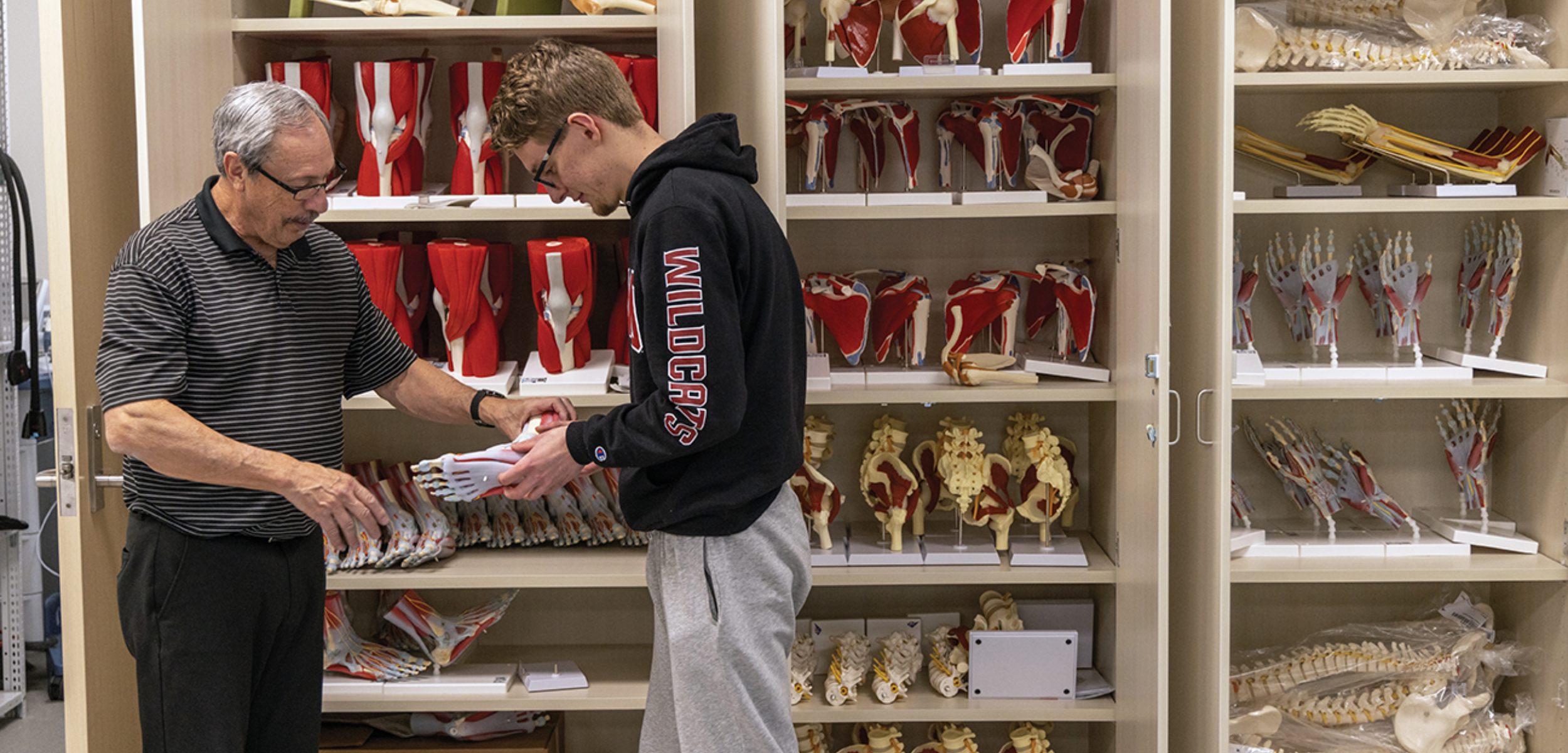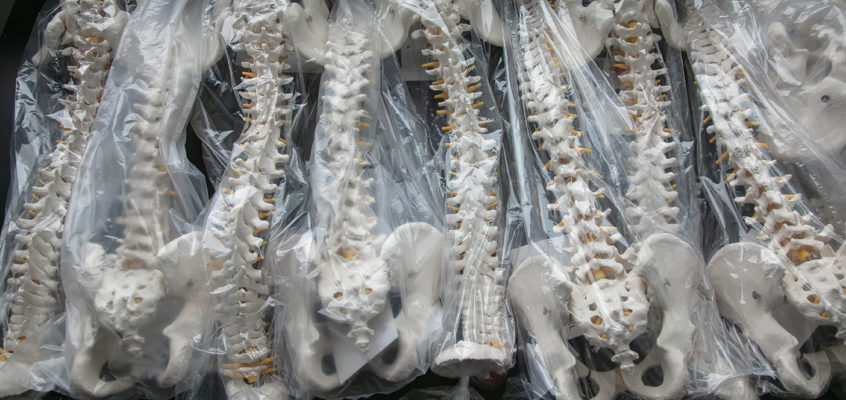
You can’t help others if you don’t help yourself first. No one understands this concept better than health sciences majors who spend countless hours mastering their craft so they can one day apply their expertise toward the common good.
A desire to improve people’s lives—along with the skyrocketing need for health care professionals nationwide—are among the main reasons so many college students these days are gravitating toward health sciences careers. The CWU Health Sciences department is keenly aware of the vital role it plays in the big picture, providing its students with a well-rounded foundation of scientific knowledge that can spawn any number of career directions.
Whether they want to become doctors, nurses, dietitians, nutritionists, dentists, physical therapists, epidemiologists, emergency medical technicians (EMT), educators, or clinical physiologists—all of which are critically needed in today’s society—health sciences majors recognize that the specialized training they receive here at Central will lead to limitless potential.
“Job prospects in health sciences are good, largely because we have excellent programs and there is a growing need for health care professionals in this state and around the country,” said Ethan Bergman, the department chair and a professor of nutrition. “Our graduates are highly sought after, and because of that, they are also able to receive good salaries right away.”
Health sciences is one of the fastest-growing professions in the country, mirroring the meteoric rise of health care-related positions over the past decade. According to the U.S. Bureau of Labor and Statistics, employment in health care occupations is projected to grow 16 percent between now and 2030—much faster than the average for all occupations—adding about 2.6 million new jobs to the national economy.
“All of our programs are very highly regarded, and we have a lot of very successful graduates that come out of CWU.”
—Ethan Bergman
The financial outlook is also brighter than most other occupations, boasting a $69,870 median annual wage for health care practitioners and technical occupations, compared to the median annual wage for all occupations ($41,950). Thanks to the training and real-world experience they receive at CWU, Wildcat alumni tend to have an advantage from the beginning.
“All of our programs are very highly regarded, and we have a lot of very successful graduates that come out of CWU,” Bergman said. “For example, our paramedicine program has been around for nearly 50 years, and many of the EMTs around the state—and even the country—were trained here.
“We also have graduates working in highly regarded PhD programs, at medical schools, the state Department of Health, the National Institutes of Health, and many other high-profile organizations,” he added. “We truly feel like we are making a difference because we are sending so much high-level talent out into the world.”
Aside from job availability and financial incentives, variety is another major draw for young professionals considering the health sciences field. The industry encompasses everything from medicine to public health; physical therapy to nutrition; optometry to medical transcription—plus a wide array of specialties that are in increasingly high demand nationwide.

Skeletal models wait to be unpacked in the Health Sciences building. It is the first time Food Science and Nutrition, Clinical Physiology, Exercise Science, EMS/Paramedicine, and Public Health have all been under one roof.
Those who enjoy helping others and seek a rewarding, lucrative career are beginning to see the advantages of pursuing the myriad health-care career opportunities that have arisen over the past decade. CWU continues to be at the forefront of this trend, and the institution has taken some important steps to solidify its role as a trusted training ground for the health sciences professionals of tomorrow.
Most notably, the university built a $60 million Health Sciences Building that opened this spring, complete with high-tech research equipment, state-of-the-art laboratories, interactive technology, and industry-specific amenities designed to give students as much real-world experience as possible before sending them out into the workforce.
“The new Health Sciences Building provides the learning environment that will allow our graduates to enter their careers with an outstanding knowledge base and experience so that they are better able to serve society,” Bergman said.
Hands-On Learning
The entire faculty is looking forward to preparing the next generation of health sciences professionals in an environment that is better-suited to the needs of today’s industry than the learning facilities previously spread across campus.
The unrivaled labs for nutrition, paramedicine, biomechanics, exercise physiology, clinical physiology, anatomy, and other disciplines have instantly elevated CWU’s stature in the health sciences education community, and these spaces will provide added incentive for prospective students and faculty to consider Central.
“This new facility will help attract more people from around the world, and that will hopefully bring more money, experience, and students to all of our programs,” said Nutrition Professor Tafere Belay, who looks forward to using the new food science laboratories for his micronutrient deficiency research.
“It’s very important that we have these state-of-the-art labs now because they will encourage more students and researchers to consider Central,” he added. “These facilities are very unique, and we need to keep promoting that.”
Similarly, the new biomechanics lab offers students and researchers with unparalleled opportunities to study human movement techniques, the impact exercise has upon skeletal muscles, the importance of proper posture, and more. The lab will provide an essential knowledge base for students, helping them “visualize physics,” according to biomechanics Professor Karen Roemer.
“For most of them, these labs are probably going to be the last time they will have access to facilities like this,” she said. “If you become a physical therapist, for example, you have to work off the knowledge you gained in your labs. You will no longer be able to use force plates to visualize force, or use the special instruments we use to monitor muscle activation.”

Assistant Professor Robert Pritchett, center, measures the oxygen consumption of Miranda Roseman during an exercise science class.
Employing real-life examples to illustrate biomechanics principles is one of the most important benefits of the new biomechanics lab, Roemer believes.
“The value of having access to these labs cannot be overstated,” she said. “These experiences have the potential to help them for the rest of their careers.”
Likewise, the Laboratory for Anatomical Discovery inside the new building is truly one-of-a-kind, especially for a regional institution like CWU. Integrative Human Physiology Professor Leo D’Acquisto believes the new lab will entice more people interested in clinical and exercise physiology, pre-physical therapy, athletic training, and pre-medicine to attend Central. The lab also will be available to high school science classes and health practitioners in the region so they can explore the inner workings of the human body in more detail.
“There aren’t many schools our size that use human cadavers as a central educational tool,” D’Acquisto said. “And now, with this laboratory, we can do even more. The new space will allow us to work with six to eight cadavers at one time, so our students can break up into small groups as they learn about the structures in the human body.”
The new anatomy lab is more than twice as large as the former space. Plus, it offers better lighting and features technology that allows students to view three-dimensional structures on screen. Anatomical models are also being used to provide a more “blended” learning environment.
“Our students get quite the experience,” D’Acquisto said. “They get to compare and contrast between models and cadavers, and that is a wonderful way to learn. The blended approach creates a rich teaching and learning environment, and that’s what we’re all about here.”
National, Global Impact
It’s difficult to exaggerate the potential impact the evolving CWU Health Sciences department—with its new building and world-renowned faculty—could have on the advancement of national, regional, and global health sciences initiatives.
Here on the home front, the demand for nurses, paramedics, public health specialists, epidemiologists, nutritionists, physical therapists, and related professions has never been higher, prompting CWU to do whatever it can to keep the professional talent pool stocked.
The Health Sciences curriculum provides students with a knowledge base that can help them in any number of careers. And just because they start in one area doesn’t mean they can’t branch off into a different discipline later on. The variety and depth of instruction offered at CWU make this possible.
“We focus on every part of the life cycle, from a woman who is thinking about having a baby, to preparing that person for giving birth, to when the baby is born, and throughout their growing years—all the way through their life,” said Bergman, the department chair.
“We then provide our students with the necessary tools to help people maintain healthy lifestyles, from nutrition to public health to clinical physiology. Our graduates come out of here with a very broad understanding of how the human body works and how to keep people healthy so they can live longer.”
Looking at health sciences from a global perspective, CWU also has the potential to influence how certain health conditions, like micronutrient deficiencies, are studied in other countries.
“Having the new building is great, but we also have a big responsibility. Now, we have all the tools and the labs that we need to do the kind of influential work that can help people around the world.”
—Tafere Belay
Belay, the nutrition professor, also sees future opportunities for the department to expand its global reach. The native of Ethiopia has spent much of his career studying third-world health conditions, and he believes it’s time for CWU students to become more involved in what’s happening around the world.
That means encouraging more health sciences students to study abroad.
“Global nutrition is a lot more complicated than what’s happening here in the U.S.,” Belay said. “When students go abroad and experience some of these differences for themselves, it encourages them to contribute more to those efforts instead of only what’s happening at home.
“Those experiences have the potential to make their future contributions even more significant,” he added. “And if we start to think more globally with regard to worldwide nutrition, I believe we can broaden our impact.”
The same holds true for public health, biomechanics, exercise science, paramedicine, and other disciplines that fall under the CWU Health Sciences umbrella. For the past dozen years, the research and training that has taken place on the Ellensburg campus has helped people lead healthier lives—and it has helped make the world a better place. Now, the department wants to shoot for the stars.
“Having the new building is great, but we also have a big responsibility,” Belay said. “Now, we have all the tools and the labs that we need to do the kind of influential work that can help people around the world. This is an exciting start, but we also have a big challenge ahead of us. And, with our amazing faculty and students, I believe Central will meet that challenge.”






comments powered by Disqus